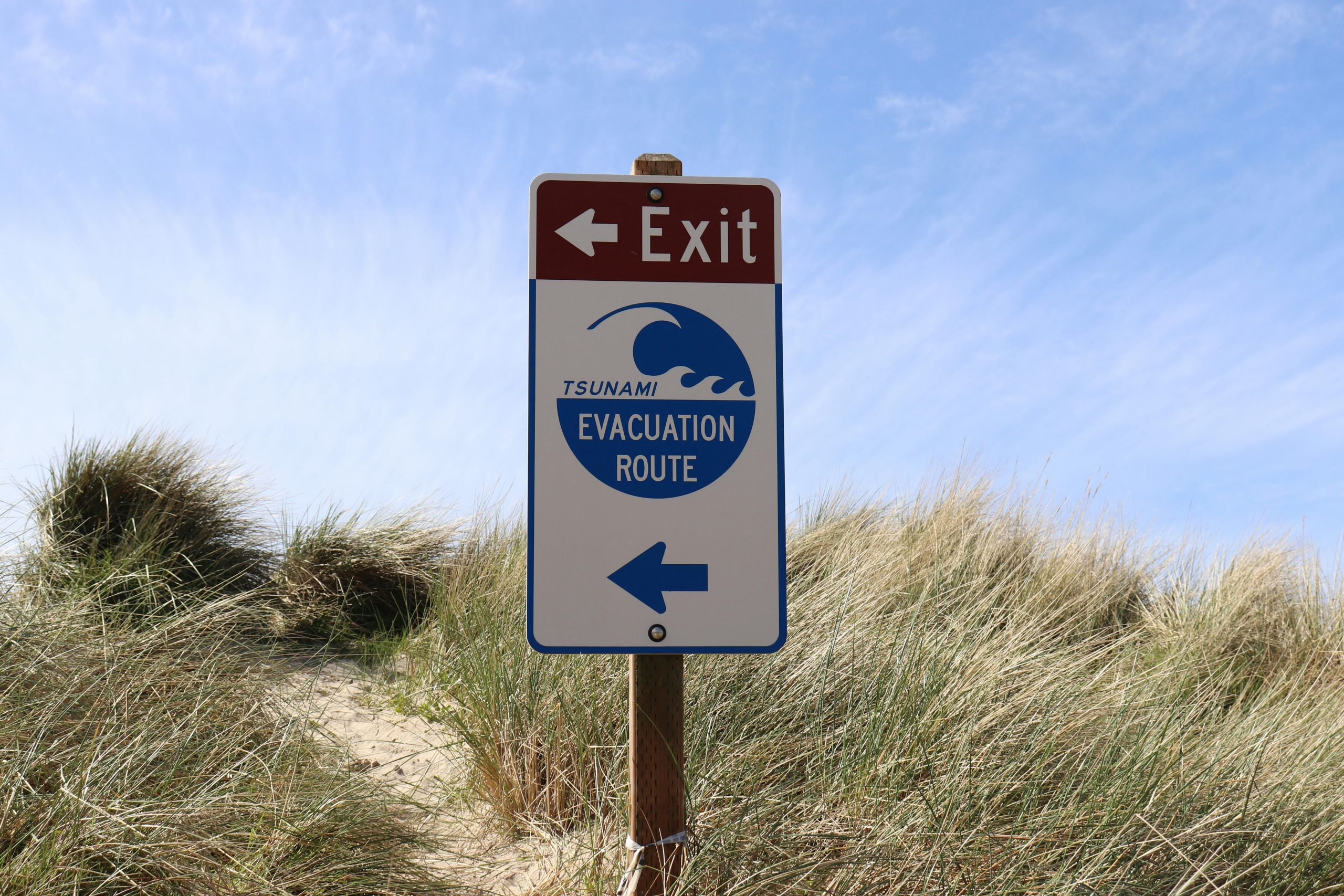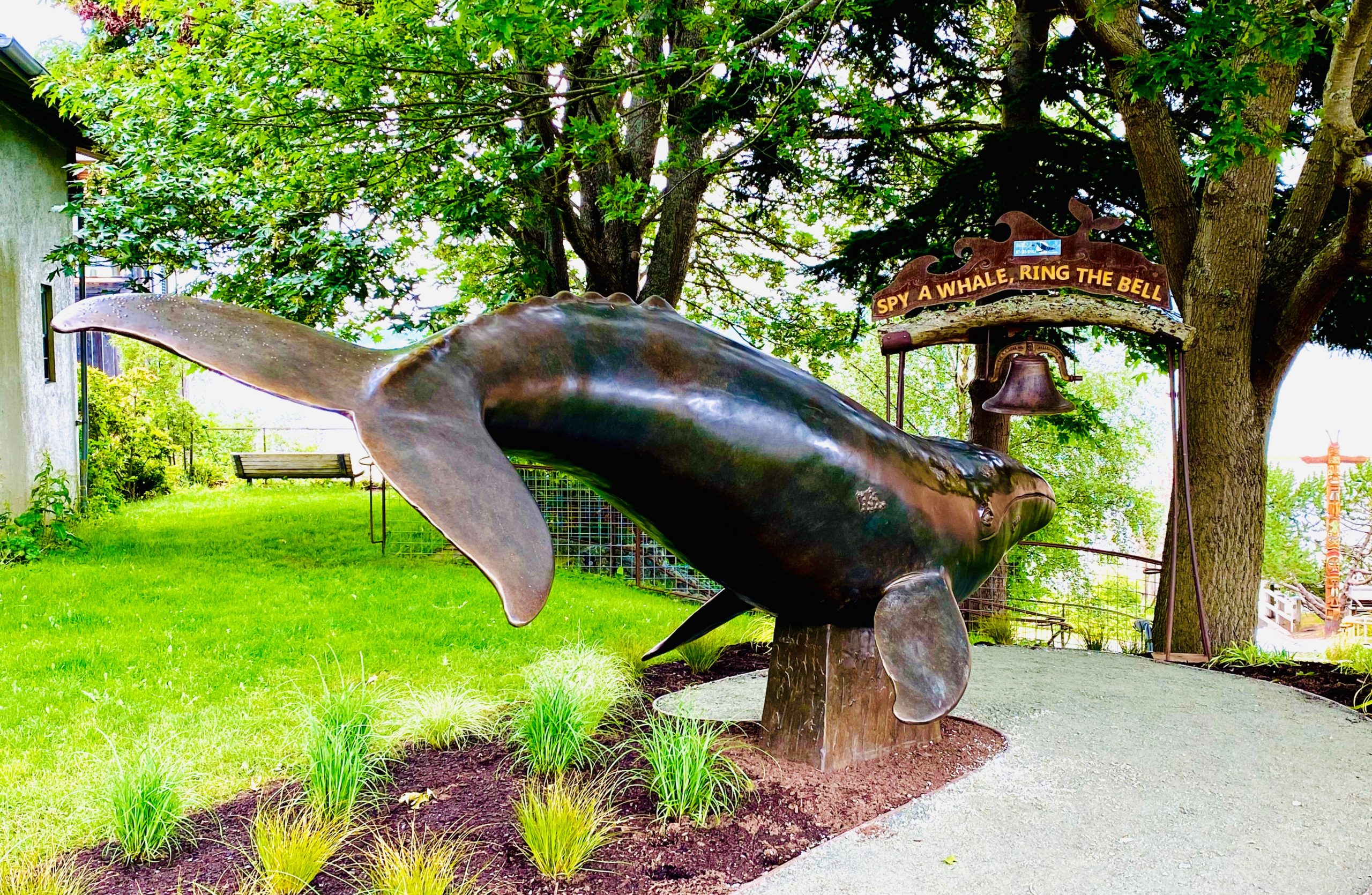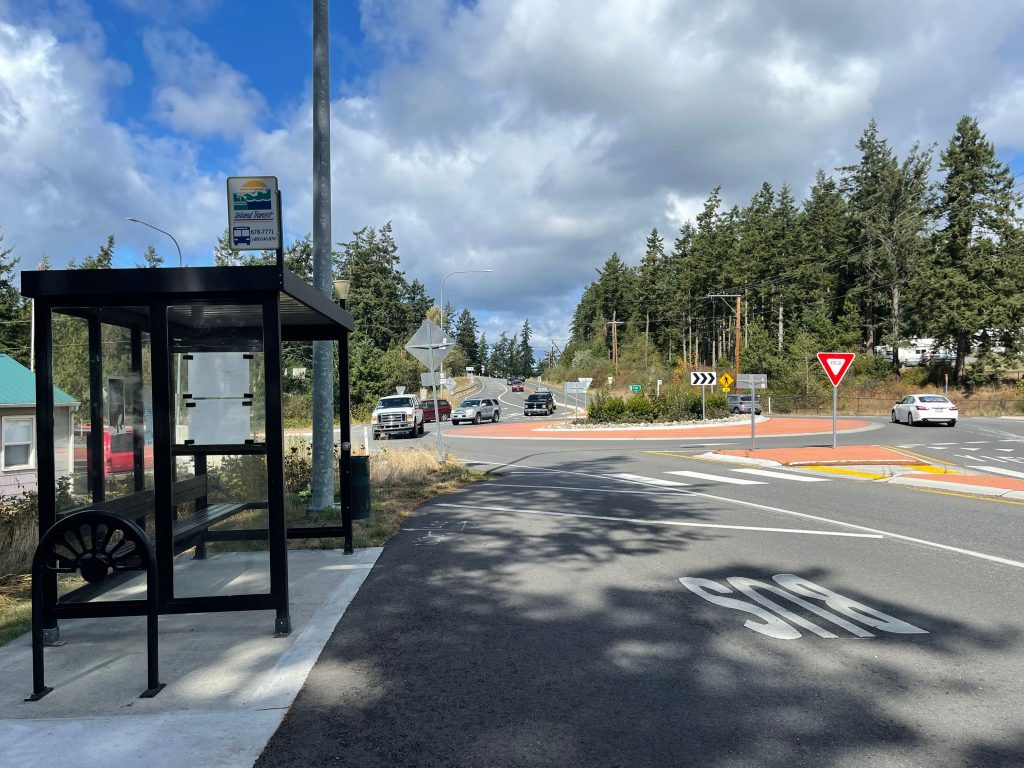Why Are There Tsunami Signs on Whidbey Island?

If you have spent any time on Whidbey Island, it is likely that you have noticed the tsunami evacuation signs posted along roads and beaches. These signs may raise questions for newcomers or visitors. Why does an island surrounded by serene waters have tsunami warnings? The answer lies in the region’s unique geography and seismic activity.
The Risk of Tsunamis on Whidbey Island
Whidbey Island is located in part of the geologically active area known as the Cascadia Subduction Zone. Roughly 600-miles of fault line runs from Northern California to British Columbia, where the Juan de Fuca tectonic plate meets the North American tectonic plate. When these plates shift or collide, they can trigger large earthquakes — and in some cases, tsunamis.
Tsunamis are massive ocean waves typically caused by undersea earthquakes or volcanic activity. While Whidbey Island is somewhat sheltered by its location in Puget Sound, a major earthquake along the Cascadia fault or from another undersea event could generate a tsunami that impacts the island’s coastal areas.
Why Are There Evacuation Routes?
The tsunami evacuation signs posted throughout Whidbey Island are part of a broader safety plan to help residents and visitors reach higher ground quickly in the event of a tsunami warning. Coastal towns like Langley, Coupeville, and Oak Harbor have low-lying areas that could be vulnerable to flooding if a tsunami were to occur.
The signs are strategically placed to direct people away from beaches, marinas, and waterfront areas toward safer locations on higher ground. Being aware of these routes and having a plan in case of an emergency is an important part of living in a coastal region. Island County does a great job of providing tsunami information including a high ground map that you can visit by clicking here.
How Likely Is a Tsunami on Whidbey Island?
The likelihood of a large tsunami hitting Whidbey Island is low, but not impossible. Scientists and geologists monitor the Cascadia Subduction Zone closely, and while large earthquakes are rare, they have occurred in the past. The most notable event was the 1700 Cascadia Earthquake, which triggered a tsunami that impacted coastal communities from Washington to Japan. You can read more about what that looked like on January 15, 2022 by clicking here.
While Whidbey Island may not face the same tsunami threats as coastal communities on the open ocean, it is still vulnerable to localized tsunamis caused by underwater landslides, known as “submarine landslides.” These could result from large earthquakes or other geological shifts in Puget Sound.
What Should You Do in the Event of a Tsunami Warning?
In the rare event of a tsunami warning on Whidbey Island, the most important thing to do is move to higher ground immediately. Familiarize yourself with the evacuation routes marked by the tsunami signs, and always follow guidance from local authorities and emergency services.
Here are a few tips to stay safe:
· If you feel strong shaking from an earthquake, don’t wait for an official warning — head to higher ground immediately.
· Know your evacuation routes and have a family emergency plan in place.
· Stay informed by signing up for local emergency alerts and having a battery-powered radio on hand.
Preparedness Brings Peace of Mind
While the thought of a tsunami can be unsettling, it is most important to remember that Whidbey Island’s local authorities and emergency response teams are well-prepared. The presence of tsunami signs and evacuation routes are simply a proactive measure to ensure everyone’s safety.
By staying informed and knowing what to do in an emergency, you can enjoy everything Whidbey Island has to offer with peace of mind. After all, living on this beautiful island means being prepared — and being part of a community that looks out for one another. Connect with us.
Working On Whidbey

Are you thinking of moving to Whidbey and wondering what working on Whidbey looks like? We’re not all retirees. Of Island County’s ~87,700 residents, ~28,000 residents have full-time jobs. (EDC Island County Profile 2020) The Navy accounts for ~11,000, so estimate that total at ~39,000. There are many retirees, children, and people employed part-time or not at all. One answer doesn’t fit all. Keep reading for the details.
The Navy Dominates
The Navy is the largest employer by thousands. If you live in or around Oak Harbor, they are hard not to notice. Some people in the military live as far south as Clinton. Others are quite far off-island and commute 45 minutes or more. Take a look at a map and notice the roads heading to the big blank space just north of Oak Harbor. Not everyone working on base are military personnel. Military bases tend to have a little bit of everything, including jobs for civilians. The base is why the Island’s population is concentrated on the north part of the island. It is also the reason there are so many businesses and jobs around it.
Airplanes Need Built
Ironically, the next biggest employer of islanders is also dealing in airplanes but is not on the Island. Boeing’s Everett plant builds the wide-body jet airplanes people are familiar with. Approximately 900 Boeing employees commute to the plant. That’s more than four times the number Walmart employs on the Island, and no on-island business is bigger. Boeing is only one example of off-island employers with island commuters. Over 35% of Island County’s employees leave the county to get to work. Some may have switched to “Work From Home”, but those jobs are in flux as employers and employees maneuver around each other while trying to find that remote vs. on-site balance.
Keep in mind, much of this data includes Camano Island because the government reports cluster data by county, as in Island County, rather than by geography, as in by island.
So, where is everyone else working on Whidbey?
As we noted, the Navy dominates with 63% of the workforce. The next biggest batch is 20% from governmental jobs like schools, city, county, state employees and hospitals. Then comes the private companies. The ones with more than ~50 employees add up to ~17%. Those three segments add up to ~100% but miss a large contingent that is harder to track. The number of people employed by small companies and entrepreneurs is about 6,000.
Understanding what works on Whidbey is different from what works in more conventional places, like big cities. Island County is officially designated as a rural county. Farm payrolls shift dramatically. Whidbey Island also has officially declared spaces that are Creative Districts. Wander around Whidbey and notice the many artists, studios, galleries, public displays, events, and performances. They also have supporting businesses supplying them with supplies, services, marketing, and such. Artists and farmers are so busy tending their projects and fields, and tend to be soloists, which means dutifully reporting data easily gets out-prioritized.
Is remote working on Whidbey a possibility?
While remote work may be a new thing for much of the world, Whidbey has also held a population of people who live here and commute to the rest of the world. Negotiating a deal in Kuala Lumpur? Your house address isn’t as important as having an airport available. Thanks to the Island’s connections, SeaTac (south of Seattle), Paine Field (close to the Clinton Ferry), and Bellingham’s international airport, a flight can be a drive, bus ride, or shuttle trip away. Canada’s even close enough that some will fly out of Vancouver’s airports when the flights are right. It is hard to track such travelers because they may be employed anywhere.
Sometimes the employers come to us, like when a movie or ad is being filmed here, or a retreat is being hosted here.
It is too easy to label such a big island with the impact of one employer. The Island has hundreds, thousands. We even have a boat builder and a few colleges.
And, of course, people move here and bring their businesses with them, or move here, and the island inspires their next enterprise.
But, retirement, or at least a sabbatical, that can work well for Whidbey too.
For a more in depth look at the data you might like to geek out on the Economic Development Council’s Island County Profile for 2020 by clicking here.
If you are considering a move to Whidbey and would like to discuss this in more detail and are not currently working with an agent connect with us to start the conversation.
Retirement in your future?

If retirement is in your near future, or perhaps you are already there (congratulations) you may find yourself wondering if staying in your home is still a good fit. When you live in a home for an extended period, it is normal for your needs to change as you progress through life’s milestones. You may find that your home is too big for the needs of this next chapter. Perhaps you have always had a dream destination in mind, whether to visit or to live or maybe you just want to be closer to family. Selling your home may just be the key to moving onto something that fits your life better.
Regardless of your why, understanding your options and the market can help you make the best next decision. We cannot stress enough that no one size fits all and suggest discussing your unique situation with a trusted Realtor. If you are not currently working with a realtor, connect with us. We will help find you the perfect match through a series of specific questions.
Follow along as we discuss why you might be in an advantageous position if you ARE considering a move and thinking about retirement.
Consideration 1: How long have you owned your home?
Today, people are living in their homes longer than they ever have in the past. The longer you live in the home the more likely that you are in a better position to sell. Let’s look at a few factors. The National Association of Realtors (NAR) shared that homeowners owned their homes for an average of six years between 1985 and 2008 whereas homeowners have been staying in their homes for an average of 9.2 years since 2009. See the graph below.

If you are like most homeowners today, you have been in your home for well over 5 years. If this is the case, it is an indicator that a move may be in your favor. Typically speaking, you have built significant equity after just 5 years in your home due to home price appreciation. The Federal Housing Finance Agency (FHFA) demonstrates this in their graph below.

If you have lived in your home for over 5 years, you might just be sitting on a large sum of money that could make your dreams a reality. The recent market has helped homeowners increase their equity by nearly 60% in the past 5 years. Those who have owned their homes since 1991 have experienced their home triple in value since they purchased it back in 1991.
Consideration 2: The Market
Currently, we are experiencing a sellers’ market. Home price appreciation is stable. There is a lack of inventory and a prediction that mortgage rates will decline. We have already begun to see the decline in rates. As rates drop, homeownership becomes an attainable option again for those looking to buy. If you are not currently working with an agent and would like to discuss a strategic plan, connect with us here.
Whether you wish to downsize, move to the destination of your dreams, have the funds to go on the vacation of a lifetime, or move closer to the ones you love, the equity in your home can help get you there.
No matter what your home goals are, a trusted realtor can help you discover the best options to get you there. They can help you sell your current home and get you into the that is right for life today.
Retirement in your future? Let’s connect and explore your options.
Weather in the Pacific Northwest

The Pacific Northwest, or PNW, is a region known for its varied and often unpredictable weather. Located in the northwest corner of the United States, the PNW is home to a diverse array of climates and landscapes, ranging from the rainy, temperate rainforests of the coast to the dry, high-desert regions of the interior.
One of the most distinctive features of the PNW weather is the rain. The region is home to some of the wettest parts of the country. Some areas receive over 100 inches of rain per year. While the rain can be a nuisance at times, it is also a vital part of the region’s ecosystem. The rain provides the water needed to sustain the lush forests and vegetation that thrive in the region.
In addition to the rain, the PNW is also prone to fog and mist, especially along the coast. These foggy conditions can last for days at a time, creating a unique and sometimes eerie atmosphere.
Weather on Whidbey Island
Whidbey Island, located in the northwest corner of Washington state, is no stranger to the PNW’s unpredictable weather. Located in the Puget Sound, the island is influenced by both the maritime climate of the coast and the inland climate of the region. As a result, the weather on Whidbey Island can vary significantly from one day to the next. Sometimes a sunshining clear skies day gives way to rain and fog in a matter of hours.
One unique aspect of the weather on Whidbey Island is its location in the rain shadow of the Olympic Mountains. The rain shadow effect occurs when moist air is forced up and over a mountain range. When this happens it causes it to cool and release its moisture in the form of rain or snow. As the air descends on the other side of the mountain range, it warms and becomes drier, creating a “rain shadow” region that receives less rainfall.
Due to its location on the leeward side of the Olympic Mountains, the areas of North and Central Whidbey Island experience this rain shadow effect, resulting in significantly less rainfall compared to other parts of the PNW. While the island still gets its fair share of rain and fog, it is generally drier and sunnier than the surrounding region. Less rainfalls makes it a popular destination for those seeking a respite from the rain.
Despite the often-variable weather, the PNW and Whidbey Island are beautiful and unique places to visit or call home. The diverse landscape and varied climate create opportunities for a wide range of recreational activities. Many people enjoy hiking and camping in the summer to skiing and snowboarding in the winter. So, whether you’re a seasoned resident or a first-time visitor, be prepared for a little bit of everything when it comes to the weather in the PNW and on Whidbey Island.
When you fall in love with the island and want to stay let us help you find your dream home. Connect with us here.
Who are you going to call

Who are you going to call? That’s up to you. How are you going to call? That’s up to you, too; but, that’s a shorter list. It is also easier to talk about. Welcome to Whidbey, or your new home, or your curiosity. Phone service on the island is unique for several reasons; and can even get into international issues. Here are some of your choices.
Landlines:
Landlines exist, and can frequently outperform more modern options. A direct connection between two phones can be clearer, simpler, and make sense in older homes. Landlines can also avoid issues about spots in a house where signals are blocked by things like masonry. They can also be handy during a power outage, if the provider keeps the lines charged. Even better is a provider that buries the lines so they’re less likely to be impacted, literally, by falling branches.
But, landlines have limits. Putting a landline in your pocket can be done, but is somewhat useless when out of range of the home’s base station. (e.g. Whidbey Telecom, Ziply)
Mobile Phones:
Welcome to the modern era when phones in pockets are taken for granted, as is roaming. One phone, one country, that’s pretty good. Cell phones, mobile phones, isn’t that what everyone uses? The major providers are here, which is definitely appreciated. As a solution, mobile phones are the dominant choice.
Mobile phones are the dominant choice, but not every provider can provide unlimited coverage. Can you hear me now? You can still hear people say that on a call as you drive through gaps in coverage. Ridges, buildings, and antenna blind spots can have you checking whether you have five bars, or as little as one bar, or even no bars. Electronic signals can’t be guaranteed to reach the base stations of the corporate carrier. Coverage is pretty good, but a temporary interruption while driving around isn’t as important as a poor signal at home. Check coverage for where you want to live.
Coverage Maps:
Find a home in the areas with your ideal coverage here.
When in doubt, drive there and check. If you are buying a home the home inspection time is a great chance to check cell reception too, make as many calls in as many spaces on the property as possible. If you get the opportunity, check in with the neighbors, possibly on social media, and learn what they use. (e.g. AT&T, T-Mobile, Verizon, US Cellular). Talk with your agent about their experience with coverage. Don’t have an agent? Connect with one here.
VIOP:
Keep in mind, some people want to live in those quiet pockets. There’s someone for everywhere.
Got a good internet connection but no cell signal? VOIP can be an option. Voice Over Internet Protocol routes your calls through the internet, not a phone landline or a cell tower. Some cell phones are already set up to choose the better path between a tower and the internet. That can be the best of both worlds. (e.g. Frontier, Vonage, Wave)
Did That Message Just Say Welcome to Canada?
Hello, Canada. Saying hello to Canada is easy enough. You can see it from the island. Wave at it. Your phone might be doing that too. The farther north and west you get on the island the greater the likelihood that your phone may connect with a tower in Canada. You can get charged for international roaming without leaving the US. Fortunately, your phone should tell you when it does that, but it is worth checking, occasionally. (e.g. Telus)
The Final Message:
The choices aren’t infinite, but there may be more than you want to research for your corner of the island. The denser the population, the more likely you’ll have plenty of choices, many of which run those big national ad campaigns. Our island’s more remote locations, however, can be so unique, so idiosyncratic, that it might make sense to visit and try calling friends and family.
As technology continues to invent new options, the choice continues to change. Now that satellite phones have progressed from specialized Globalstar handheld units to Starlink’s internet access a homeowner can create their own connection, assuming those pesky hills and bills don’t get in the way. If you’ve got power and the right view, you’ve got internet and phone; regardless of whatever might be interrupting everyone else’s day or night.
Who are you going to call? That’s up to you. How are you going to call? That’s up to you, too; but, now you may understand why one answer doesn’t apply to everyone. Thanks, Ma Bell and your old bakelite landline phones wired to a wall; but, we’ve become much more mobile, and hopefully more stylish. Make a call from Whidbey? You’ve got options. Try to call us now: 360.675.5953.
HALLOWEEN IS CREEPING CLOSER

As the crisp autumn air settles in, Halloween is creeping closer and it’s time to conjure up some devilishly delightful pumpkin carvings.
SPOOKTACULAR CARVING IDEAS:
Whether you’re a seasoned pro or a beginner, these spooktacular pumpkin carving ideas are sure to impress.
Start off with a classic Jack-o’-Lantern, featuring a toothy grin and triangle-shaped eyes that never go out of style. Or try a simple yet spooky ghost design with black paint or markers to create a hauntingly eerie look. If you prefer something more whimsical, carve a cute cat with pointy ears and whiskers to add a playful touch to your décor.
But… if you are feeling daring, go all out with a fierce dragon carving. Of course, it will require expert level skill and patience, but it is sure to leave everyone spellbound. For a more elaborate design, try carving a haunted house complete with spooky windows, a creaky door, and ghostly apparitions floating around – perfect for adding an extra eerie ambiance to your Halloween décor.
WHIDBEY ISLAND FARMS:
Once you have your design picked out, head over to one of Whidbey Island’s pumpkin patches to find the perfect pumpkin.
At the Greenbank Farm enjoy a fun day of picking your own pumpkins.
Case Farm offers over 50 years of experience in growing a variety of pumpkins.
While the Bayview Farmers Market has a pumpkin patch, it also offers a variety of vendors selling fresh produce, baked goods, and handmade crafts.
But don’t stop there – Whidbey Farm & Market and The Farm Stand K & R Farms also offer great pumpkin picking options. At the Whidbey Farm & Market, you can support local farmers and artisans while picking out your perfect pumpkin for carving and at The Farm Stand K& R Farms, enjoy a variety of fresh produce and family-friendly activities like a corn maze and ice cream.
HALLOWEEN FUN ON WHIDBEY:
To top off the fun, if you are looking for a spooktacular adventure, head over to the Haunted Barn In Oak Harbor. The haunted barn features creepy decorations, special effects, and live actors sure to send shivers down your spine.
No matter where you choose to pick your pumpkins or celebrate Halloween, make sure to enjoy the crisp fall weather and embrace all the spooky sights and sounds of the season. Happy haunting!
Whale Park in Langley

Have you heard the whale bell ring while in Langley in the spring? While that is a nice rhyme it is also a legitimate question. Every spring gray whales feed off ghost shrimp in the muddy shallows just off the shore. If you are lucky, they will come right up to the seawall! The bell and “Hope the Whale” are the stars of this iconic park. What some people miss is that the blowholes in “Hope” are there to collect money to fund ADA modifications to improve access to Seawall Park below. This will help everyone see the whales when they arrive. Bring your coins and listen to the clang!
Check out the rest of Whidbey’s beautiful destinations from this series here.
Island Transit on Whidbey Island

Island Transit is the public transportation system serving Whidbey Island, located in the Puget Sound region of Washington state. The system consists of fixed-route buses and paratransit vans, as well as additional programs such as vanpools and bike locker rentals.
Island Transit began on December 1, 1987 as a response to the increasing traffic congestion and lack of transportation options on Whidbey Island. Today, the system serves a population of approximately 73,000 people, covering a service area of approximately 400 square miles. The buses pick up passengers from bus stops like the Northgate Terrace bus stop pictured above throughout all of Whidbey Island.
In addition to its fixed-route buses, Island Transit also operates a paratransit service for individuals with disabilities who are unable to use the fixed-route buses. The paratransit vans offer door-to-door service and can be reserved by calling Island Transit in advance.
Island Transit’s vanpool program is a convenient and cost-effective alternative for commuters who travel long distances or have irregular work schedules. Participants in the program share the cost of gas and vehicle maintenance and can save money on the cost of driving alone.
The bike locker rental program allows riders to securely store their bike at a convenient location and use it to complete the first or last leg of their commute. The lockers are located at select bus stops and can be rented on a monthly basis (check out prices and apply here) in addition to public use lockers that are on a first come first served basis.
In recent years, Island Transit has made efforts to increase sustainability and reduce its environmental impact. Learn more about their initiatives here. As a result, hybrid buses have been added to its fleet all while keeping Island Transit buses fare-free.
Overall, Island Transit plays a vital role in the transportation needs of the residents and visitors of Whidbey Island. The convenient and reliable services, as well as its vanpool and bike locker rental programs, make it a valuable asset to the community.
If you have further questions or are interested in learning more about living on Whidbey Island please do not hesitate to connect with us. Contact us here.
View this post on Instagram
Langley Pelicans

Did you know that well over a century ago White Pelicans were common in our area? Unfortunately, the use of pesticides and a change in habitat threatened the species. For years, these gorgeous birds went relatively unseen until a flock graced our South Whidbey waters in 2016 visiting Deer Lagoon and Honeymoon Bay. With the loss of breeding grounds, these huge birds are known to prospect new locations and have returned to Deer Lagoon every year since. Bird watchers now anxiously await these feathered friends every year. Will you be one of the lucky ones to spot them?
If you are or are interested in becoming an avid birdwatcher check out our blog Bird Watching on Whidbey Island here.

 Facebook
Facebook
 X
X
 Pinterest
Pinterest
 Copy Link
Copy Link






